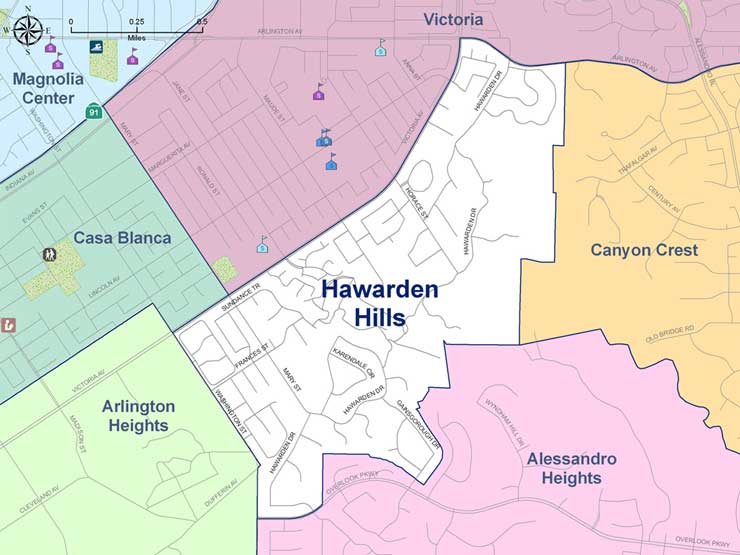The name Hawarden originated in the British Isles and comes from Flintshire, North Wales, where Hawarden castle, town and civil parish are located. The English descendants who invested in and occupied Arlington Heights, brought names they were familiar with in the British Isles. The Hawarden Hills area was included in Riverside's original 39.4 square miles when it incorporated in 1883.
Around the turn of the Twentieth Century, portions of the neighborhood were developed with home-sites on large lots used for citrus agriculture. Riverside's "citriculture" beginnings are still present today in the many City Landmarks that grace the area and the active orange groves in the adjacent Arlington Heights neighborhood.
Victoria Avenue, the Gage Canal, Orchard House, a Tudor Revival style house constructed from 1917-1920 for citrus grower and prominent attorney William G. Irving and Greystones, and a Classical Revival style house built in 1902 are all City landmarks that enrich the neighborhood and the City of Riverside. Victoria Avenue borders the northwest edge of the neighborhood and the Gage Canal runs through the neighborhood from the Victoria neighborhood to the north to Arlington Heights to the south. The Orchard House and Greystones are both located along Hawarden Drive within the neighborhood.
Today, the Hawarden Hills neighborhood is developed primarily with single-family residences on mid-sized and estate lots, but also contains a small number of planned residential developments along Victoria Avenue. Much of the residential area was built between 1970 and 1990 and is split roughly evenly between mid-sized and estate lots. Streets follow the natural contour of the hilly terrain to produce winding roadways that offer variety and interest to the neighborhood streetscape. According to the 2000 Census, Hawarden Hills has the second highest average property values and income levels in the City.
The neighborhood has a variety of natural features which gives it a unique character. The eastern portion of the neighborhood includes steep hilly terrain. The Alessandro Arroyo, one of six major arroyos within the City, runs from east to west through the southern portion of the neighborhood. The arroyo serves not only as a conduit for water, but contains rich and varied areas of animal and plant life. Residential development has occurred in a manner designed to protect and preserve the arroyo along with much of the natural hilly terrain of the neighborhood.
The neighborhood has convenient access to several fine public facilities. Located just a short distance northwesterly of the neighborhood, schools include Poly High School, Gage Middle School, Washington and Victoria Elementary Schools and the California School for the Deaf. Also located nearby are Washington Park and the extensive walking paths and bike trails along scenic tree-lined Victoria Avenue.


